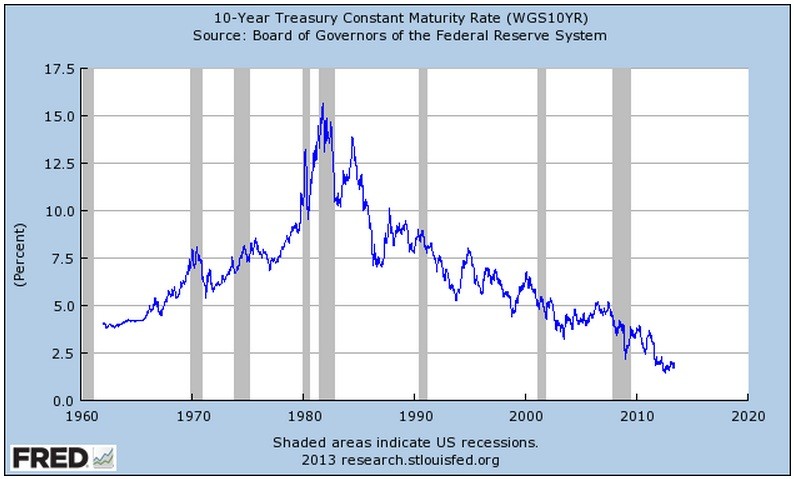Long Term Treasury Bond Yields v Yields
Post on: 26 Апрель, 2015 No Comment

Using the Risk Premium as a Quick and Dirty Gauge of Market Valuations
In the 1987 shareholder letter to GEICO stockholders, Lou Simpson, one of the most successful investors of all time, described what he looked for in a potential investment. They included Think independently, Invest in high-return businesses run for shareholders, Pay only a reasonable price. even for an excellent business, Invest for the long-term, and Do not diversify excessively. He also mentioned a concept that we have only briefly touched upon and that is the long-term treasury yield and how it has important implications in the valuation you should use to determine the relative attractive of a company.
As humans, we have a deep need for benchmarks; standards against which all other things must be measured. On Wall Street, everything gets compared to long-term treasury bond yields. These bonds, issued by the Federal Government to raise funds for day-to-day operating needs, are considered the “risk-free” rate because there is no reasonable chance of default. Why? Congress has the power to tax. If the government were unable to meet its obligations, our representatives on Capitol Hill would merely need to jack up tax revenues. (Of course, in such a situation, inflation may have begun to run rampant meaning that although you would get your money back, the actual value of those dollars as measured in terms of how many hamburgers or boxes of laundry detergent you could buy would be worth far less.) At the time of this article, the 30-year Treasury yielded 5.22%. For a great discussion of that topic, you might find Reading Between the Lines — How to Use the Spread Between Treasuries and TIPs to Gauge the Market’s Inflation Outlook interesting.
The theory behind this benchmark is that every investor in the world should ask himself (or herself) first and foremost: “If I can earn 5.22% on my money without taking any risk, what premium should I demand for riskier assets such as stocks?” Of course, most people don’t actually pose the question to themselves this way. Instead, they may look at shares of Coca-Cola and determine that at a price-to-earnings ratio of 23 (which means an earnings yield of 4.34%) they aren’t willing to invest. Or, they may conclude that Coke has growth prospects – whereas the treasury does not – and it has the ability to weather a storm in the event of widespread inflation. People are still going to drink soda, even in the midst of a great depression because it is, as the company has pointed out, an “affordable luxury.”
Risk Premium
Economists love to take the estimated risk premium for the market at any given time and compare it to the past. Often, this can reveal widespread over or undervaluation. Think back to the dot-com bubble. At its height, the S&P 500 had a price-to-earnings ratio in excess of 60. This is an earnings yield of only 1.67%. At the time, the risk-free rate was roughly 5.90%. That means that people were able to make 5.90% without any risk, but given chance of wipeout from risky, newly formed companies, they demanded only 1.67%! It’s no wonder that long-term value investors were sounding the warning. During such speculative orgies, however, reason is often derided as a Cassandra; an inconvenience that simply doesn’t understand that things are “different this time.”














